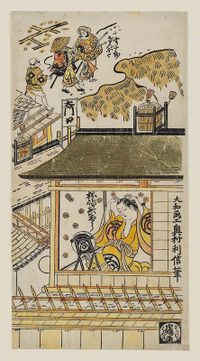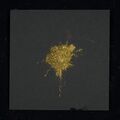Difference between revisions of "Category:Brass: Ukiyo-e colorant"
| (3 intermediate revisions by the same user not shown) | |||
| Line 2: | Line 2: | ||
[[File:SC204072.jpg|right|200px|link=Toshinobu, Actors Matsushima Hyôtarô as the Courtesan Senzai and Nakamura Ujûrô and Nanboku Magotarô as Samurai, 11.13225|Actors Matsushima Hyôtarô... by Okumura Toshinobu]] | [[File:SC204072.jpg|right|200px|link=Toshinobu, Actors Matsushima Hyôtarô as the Courtesan Senzai and Nakamura Ujûrô and Nanboku Magotarô as Samurai, 11.13225|Actors Matsushima Hyôtarô... by Okumura Toshinobu]] | ||
| − | <font size="3">'''[[Brass]]'''</font> 真鍮(''shinchū''): | + | <font size="3">'''[[Brass]]'''</font> 真鍮 (''shinchū''): Brass is an alloy of [[Copper|copper]] and [[Zinc|zinc]]. During the Edo period, brass was made with domestic copper and imported zinc from China. |
| − | Brass flakes are found in early prints as well as in deluxe editions. It was also used for metallic gold colored areas on a print. Printed brass is often seen in | + | Flakes or powdered metallics are often found in deluxe editions and ''surimono'' prints (摺物). [[Animal glue]] (膠 ''nikawa'') was commonly used to adhere the powder to the paper's surface or as a binder when printed. The use of affordable metals such as brass and [[:Category:Tin: Ukiyo-e colorant|tin]] were likely meant to imitate the glittering effects created by the use of expensive metal leaf or flakes such as gold and silver on screen and scroll paintings. |
| + | |||
| + | Brass flakes are found in early prints as well as in deluxe editions. It was also used for metallic gold colored areas on a print. Printed brass is often seen in surimono prints. Different tones of brass could be created by manipulating the proportion of copper and zinc. | ||
'''For additional information see:''' [[Brass]] | '''For additional information see:''' [[Brass]] | ||
| + | <br> | ||
<br> | <br> | ||
| Line 45: | Line 48: | ||
X-ray fluorescence analysis (XRF) is used to detect copper (Cu) and zinc (Zn), which is an indication for the presence of brass. | X-ray fluorescence analysis (XRF) is used to detect copper (Cu) and zinc (Zn), which is an indication for the presence of brass. | ||
<gallery mode="packed" heights="200px" style="text-align:left;"> | <gallery mode="packed" heights="200px" style="text-align:left;"> | ||
| − | brass xrf.png|<center>XRF spectrum for | + | brass xrf.png|<center>XRF spectrum for Brass</center> |
</gallery> | </gallery> | ||
Latest revision as of 21:12, 24 April 2024
Brass 真鍮 (shinchū): Brass is an alloy of Copper and Zinc. During the Edo period, brass was made with domestic copper and imported zinc from China.
Flakes or powdered metallics are often found in deluxe editions and surimono prints (摺物). Animal glue (膠 nikawa) was commonly used to adhere the powder to the paper's surface or as a binder when printed. The use of affordable metals such as brass and tin were likely meant to imitate the glittering effects created by the use of expensive metal leaf or flakes such as gold and silver on screen and scroll paintings.
Brass flakes are found in early prints as well as in deluxe editions. It was also used for metallic gold colored areas on a print. Printed brass is often seen in surimono prints. Different tones of brass could be created by manipulating the proportion of copper and zinc.
For additional information see: Brass
Examples of Brass in Ukiyo-e Prints

|

|

|

|

|
Analysis
X-ray fluorescence analysis (XRF) is used to detect copper (Cu) and zinc (Zn), which is an indication for the presence of brass.
Images of Brass
List of Prints
Below is a list of prints where brass was detected.
Pages in category "Brass: Ukiyo-e colorant"
The following 9 pages are in this category, out of 9 total.
B
S
- Shigenobu I, Urashima Tarô, from the series A Set of Five Examples of Longevity, 21.9254
- Shinsai, Chapters 22–24, from the series The Tale of Genji, 11.20034
- Shunman, Mandarin Ducks and Iris, from the series Series of Seven Bird-and-Flower Prints for the Fuyô Circle of Kanuma in Shimotsuke Province, 21.9226




